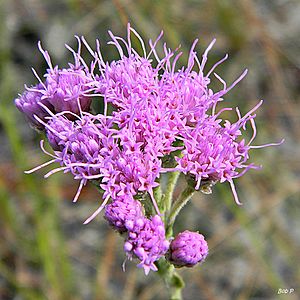Carphephorus facts for kids
Quick facts for kids Chaffheads |
|
|---|---|
 |
|
| Carphephorus corymbosus | |
| Scientific classification | |
| Kingdom: | |
| (unranked): | |
| (unranked): | |
| (unranked): | |
| Order: | |
| Family: | |
| Tribe: |
Eupatorieae
|
| Genus: |
Carphephorus
Cass.
|
| Type species | |
| Carphephorus pseudoliatris Cass.
|
|
Carphephorus is a group of plants found in North America. They belong to the sunflower family. These plants grow naturally in the southeastern United States, from Louisiana all the way to Virginia. People often call plants from this group chaffheads.
Contents
What are Chaffheads Like?
Chaffheads are perennial plants. This means they live for more than two years. They grow from a thick base called a caudex and have many thin roots spreading out.
Their stems stand straight up and usually don't have branches. They typically grow about 20 to 60 centimeters (8-24 inches) tall, but can sometimes be taller. The leaves are arranged one after another along the stem, pointing upwards. They can be hairy or smooth and often have tiny glands.
The flower heads grow in open clusters. Each head can have up to 35 tiny flowers called disc florets. These flowers are usually lavender, dark magenta, or pinkish-purple. Sometimes they can even be blue!
After the flowers bloom, they produce a ribbed, rough-textured fruit called a cypsela. This fruit has a tuft of bristles on top, called a pappus. The pappus helps the seeds float away in the wind.
How Chaffheads are Classified
Scientists sometimes disagree on how to group these plants. Some experts think certain chaffhead species should be in their own separate groups, like Trilisa and Litrisa. They base this on small differences in the flowers.
However, other scientists believe all these species are similar enough to stay in the Carphephorus group. Studying the plants' DNA (called molecular data) might help solve this puzzle.
Carphephorus plants are part of a larger group called the Eupatorieae tribe within the aster family. Like other plants in this tribe, their flower heads only have disc florets (the tiny tube-shaped flowers in the center). They do not have ray florets (the petal-like parts you see on a daisy).
They are also in a smaller group called the Liatrinae subtribe. Other plants in this subtribe include Liatris and Garberia.
Types of Chaffheads
Here are some of the different species and varieties of Carphephorus:
- Carphephorus bellidifolius – This is known as the sandywoods chaffhead. You can find it in Georgia, South Carolina, North Carolina, and Virginia.
- Carphephorus carnosus (also called Trilisa carnosa) – This is the pineland chaffhead. It grows in Florida.
- Carphephorus corymbosus – This is the coastal plain chaffhead. It lives in Florida, Georgia, and South Carolina.
- Carphephorus odoratissimus (also called Trilisa odoratissima) – This plant is known as vanillaleaf. It grows across many states: Louisiana, Mississippi, Alabama, Florida, Georgia, South Carolina, and North Carolina.
- C. odoratissimus var. odoratissimus
- C. odoratissimus var. subtropicanus – Sometimes this is considered its own species. It grows further south and doesn't have the vanilla-like smell. It's also smaller and grows in a rosette shape, meaning its leaves form a circle close to the ground.
- Carphephorus pseudoliatris – This is the bristleleaf chaffhead. You can find it in Louisiana, Mississippi, Alabama, Florida, and Georgia.
- Carphephorus tomentosus – This is the woolly chaffhead. It grows in Georgia, South Carolina, North Carolina, and Virginia.
Plants Formerly in This Group
- Carphephorus paniculatus (now called Trilisa paniculata) – This plant, known as hairy chaffhead, used to be in the Carphephorus group. It grows in Alabama, Georgia, Florida, South Carolina, and North Carolina.
Plant Chemistry
Some chaffhead species have special oils that evaporate easily. These oils give the plants their unique smells. For example, some have a scent like vanilla, which comes from a chemical called coumarin.
See also
 In Spanish: Carphephorus para niños
In Spanish: Carphephorus para niños

